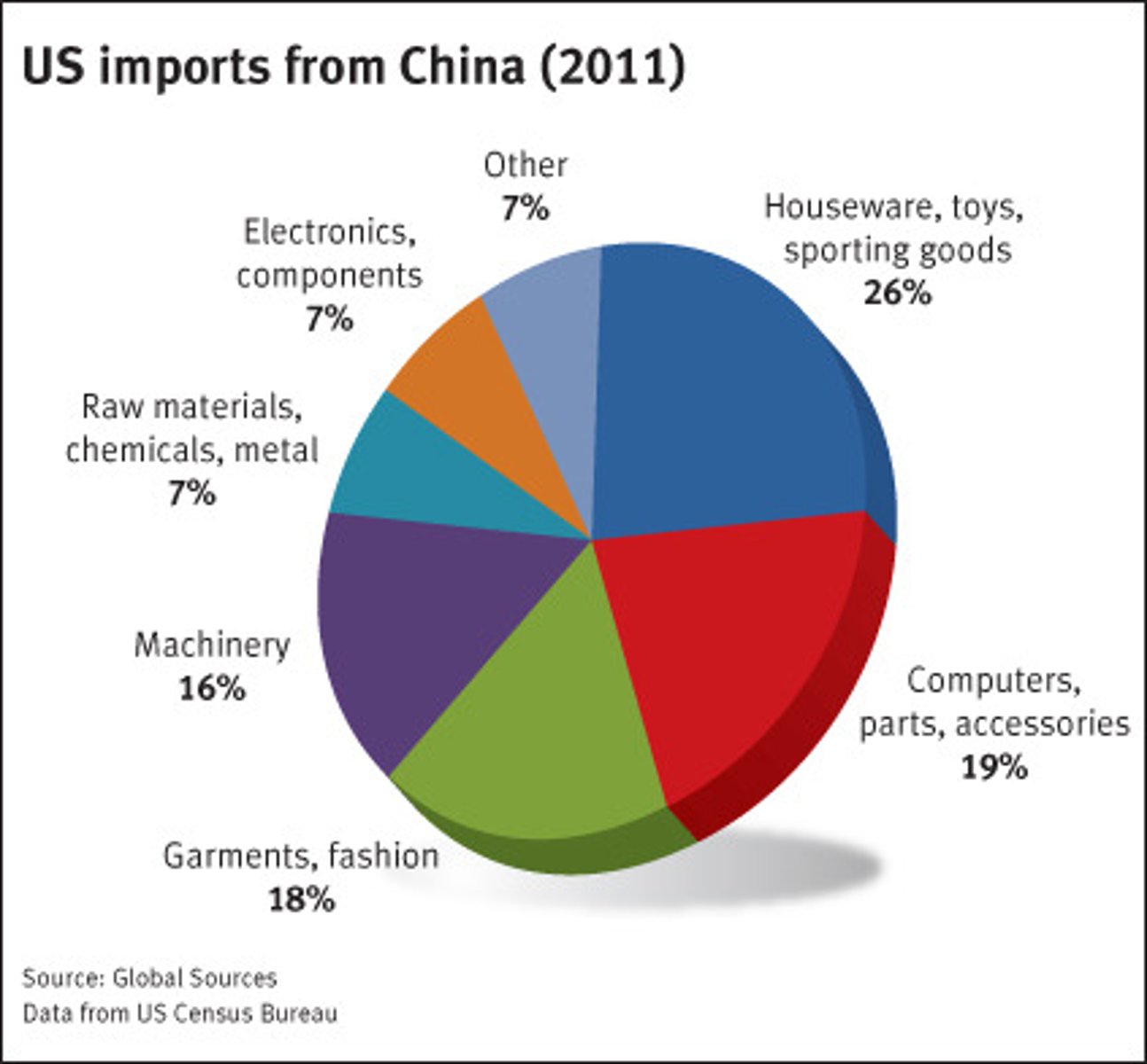Pattern of Production, Distribution and Consumption (4)
1/23
There's no tags or description
Looks like no tags are added yet.
Name | Mastery | Learn | Test | Matching | Spaced |
|---|
No study sessions yet.
24 Terms
production
The process of creating goods and services
developed markets dominate the global exports of manufactured goods, especially in EU and US
containerisation
= the transport of goods via large shipping vessels which can carry huge containers
e.g., HMM Algeciras
protectionism
= the policy of protecting domestic industries against foreign competition through tariffs, import quotas and subsidies/other restrictions placed on imports of foreign competitors
e.g., farming is subsidised in the uk
tariffs
= a tax charged on goods/services as they move from one country to another (imported goods)
economics of scale
= reduction in the cost of production as volume of production increases, produce more of the same thing at a cheaper cost - spreading the cost and rationalisation operations
high level services
= services to businesses
e.g., finance, investments, advertising
low level services
= services to consumers
e.g., travel and tourism, customer call centres, communication services
WTO
world trade organisation
... regulates world trade through negotiations of trade barriers
R&D
retail and development
(quaternary industry)
Footloose
= an industry that can be placed and located at any location without the effect from factors, don't have ties, can still serve the needs of customers worldwide
e.g., resources, transport
agricultural production
EU and US are the top exporters of agricultural products...
but
...many emerging economies at in the top 10
(Brazil, china, indonesia, argentina, india)
fuels and mining production
EU = top exporter of fuels + mining products
large majority of emerging economies in middle-east are large producers due to oil industry
russia, saudi arabia, UAE, and Qatar = top 10 exporters
steel and iron production
the EU dominated in iron and steel exports
many BRICs are also large exporters
china, russia, india, brazil and ukraine = all top 10 exporters
textiles production
EU and US dominating the industry, several emerging economies are dominating textile exports
india, turkey, pakistan and vietnam (which is not even considered an emerging economy as is too small of a market) = all major exporters
chemicals production
chemical exports are dominated by the EU, then the US
there are many developed economies exporting chemicals, including Switzerland, Japan and Canada
chemical exports within emerging economies are also high
clothing production
although the EU is 2nd largest exporter of clothing, the majority of clothing exports are highly concentrated in LICs
(some even too poor to be considered emerging economies)
china = highest exporter of clothing (+ India, turkey, Indonesia - all emerging economies)
vietnam, cambodia, Bangladesh = all large exporters of clothing
industry = heavily based in LICs
office production
although the US and the EU are on the top 10 exporters, the majority of office exports are concentrated in emerging economies
china (makes up 1/3rd of entire market), Singapore, South Korea, Taiwan, Mexico and Malaysia make up the top 10
amount of equipment produced in these regions is likely due to cheap labour prices, and ability to make and ship products in bulk
automotive production
HICs and developed markets make the majority of automotive products
(the EU, Japan, US, Canada)
Mexico, China, Thailand, India and other emerging markets are also becoming large exporters of automotive products
industry is very much in the developed markets
international division of labour
= highly skilled, highly paid, decision making research and managerial occupations are concentrated in more developed countries
e.g., USA
= unskilled, poorly paid assembly occupations tend to be located in developing countries that have lower labour costs
e.g., indonesia
has occurred because of globalisation and flows of capita
the shift in division of labour
from then to now...
- 1954, 94% of manufacturing was in industrialised economies of Western Europe, North America and Japan
=>decentralisation due to FDI
... production located abroad at lower costs
= the GLOBAL SHIFT
- structural unemployment in many countries as industry has been taken away
- LICs can develop in the economy and benefit from this
decentralisation
= shifting away from highly industrialised industries due to FDI
example of International division of labour: Primark
located in Ireland, 408 stores, most of which are located in England and Spain
- international labour = located in china and Bangladesh, headquarters in Ireland, joined NGOs in 2006
- says that they keep prices low as they can produce large quantities of items at lower costs this way
... and tend not to spend money on things that other companies do
- 50 years ago, only 10 stores in Ireland, all products would've been made locally, now 408 stores around the world
- workers in china and Bangladesh exploited by company, paid low wages and in poor working conditions
... people have found SOS notes with items of clothing detailing poor quality of life
April 2013, 1,100 died and 2,400 injured as a factory in Bangladesh collapsed
=> child labour and fast fashion
distribution
= refers to the way something is spread out or arranged over a geographic area
... where products and services are sold globally
consumption
= refers to the purchase of products or services
imports of goods from other country
in general, HICs consume manufactured products more than LICs
... a lot less demand for goods in LICs
... developing economies = high demand for fuel and minerals due to rapid industrialisation
(Brazil, china, india)
least developed countries, imports = low
... in Chad, DRC, Georgia and Uzbekistan import medical supplies more than any other country
